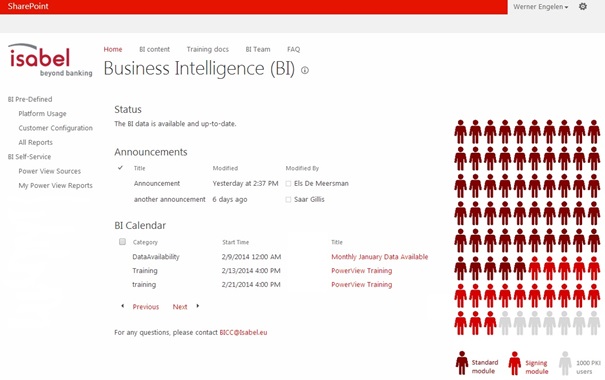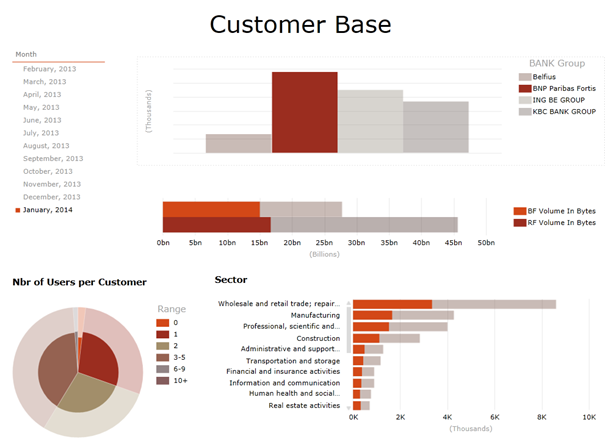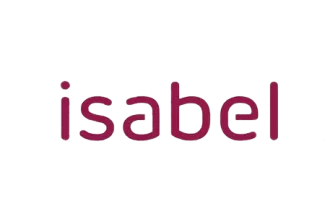This case study discusses the Analytics platform that Isabel Group has been setting up with element61 in 2012.
In 2022, element61 assisted Isabel Group in an Azure Cloud Migration project of this Data Platform.
The Customer
The financial value chain of companies, government agencies and consumers has changed considerably in the last years. Today efficiency and ease of use have replaced paper transactions and data re-entry. Isabel helps its customers to make their invoicing and payment flows as smooth as possible. Therefore Isabel offers two different solutions.


Bankit is an integrated internet banking solution for professional users. It offers multi-bank, multi-user, multi-sign and multi-encoded functionalities, by which a company can choose from a wide variety of automation capabilities and which can easily be integrated with the customers accounting software. Via one application, one card and one personal pin code, a company has access to over 20 banks.
Zoomit offers a free service in internet banking for consumers, where one can manage invoices & payslips and pay those invoices in a few clicks quickly and easily within the customers internet banking applications. This service is offered more and more by a variety of organizations.
Isabel was founded in 1995 by 4 major stakeholders, being KBC, ING, BNP Paribas Fortis & Belfius.
The company services over 100.000 companies and processes more than 300 million transactions per year. As such more than 1.500 billion euro is processed on a yearly basis. For more than 15 years, Isabel has been a technology-oriented company while today Isabel is shifting more & more towards a customer oriented organization.
BI shows an important added value in truly identifying customers and their characteristics. By gathering all relevant information (like loyalty, activity, sector, size and many others), Isabel wants to enable a better view on it customers, resulting in providing better services and as such growing the company.
The Challenges
In 2012 Isabel asked element61 to review their existing Oracle data warehouse and at the same time train key staff on BI best practices & Business Intelligence Competence Centers (BICC).
Given the fact that Isabel provides complex technological oriented financial solutions towards its customers it is key that BI at Isabel is able to offer information which is accurate, easy to use, transparent and above all information which provides answers to complex and domain crossing business questions.
The existing data warehouse however was an initiative which started from a purely technical perspective on what was available instead of a business perspective on what was really required, next to a lack of knowledge on advanced dimensional modeling, front-end & back-end best practices, project methodology, formal testing process & corresponding dedicated BI-tools. Nearly no documentation was made available, neither on business terms used, neither on where does which information originate from or how is the data transformed throughout the different data warehouse stages to name but a few. And finally the information was only made available on a monthly basis through basic unrelated database tables instead of a combination of advanced star schemas and OLAP cubes.
Other challenges included:
- Previously different data warehouse-like initiatives were executed, which had proven to be unsuccessful. As a consequence, Isabel staff is a bit biased and doesn't have a lot of confidence in just another BI project
- In terms of dedicated ownership: it isn't always easy to find a business owner to provide the necessary required information, due to lack of time (people do this on top of their normal job) and / or due to lack of knowledge (as the company is in full transition, there are permanently position switches)
- Data quality which is looked upon too much from an operational perspective
- Limited amount of operational data availability (e.g. only 3 months of data available on certain operational database tables)
- A strictly operational ICT Solution release rhythm (Isabel wants to offer new or improved functionality to its customers which causes changes in the operational systems and at the same time results in new business requirements and changes in available/collected data sets)
- Limited access to representative data due to security regulations
- Complex infrastructure setup due to security regulations
Within the context of BI, Isabel received training on dimensional modeling, the Microsoft BI offering, BI project methodologies & BI architecture. Within the context of BICCs, amongst others the following topics were discussed: BI & organizational challenges, BICC services, BICC roles & responsibilities, funding and setting up a BICC.
Solution
Part 1 - Initiation
Based on the results of the assessment, Isabel decided to replace the existing data warehouse solution by a Microsoft BI solution and at the same time define a BI Roadmap for the next years.
Initially, the existing domains were re-designed and implemented. Within this track the main focus was on the usage of the bankit platform. More detailed and richer models were defined, which introduced more advanced insights in how customers were uploading & downloading information when using the bankit platform; which software, formats, wizards, transaction types amongst others are being used.
Next to this, information is captured on a weekly basis, concerning the profiles related to the security tokens or smart cards which Isabel users are using to connect to the bankit platform. As such PC configuration information such as internet versions, screen resolutions, browser versions and many more can be analyzed in detail in function of customer problems or complaints; when -for example- an issue is detected related to customers using Windows XP, then immediately the correct user population can be contacted in a pro-active manner. Next to that, the information also shows its added value in function of new Isabel platform releases when impact analyses are to be executed.
For obvious reasons, a customer dimension was needed. The customer dimension however showed an above average complexity. An Isabel customer consists out of a billable component who is paying for the invoices, multiple subscribing entities who are using the services, multiple contracts, multiple users and possibly multiple security tokens. Additionally contracts & users always have an Isabel perspective and a bank perspective and finally an Isabel customer is owned by a registration authority bank and can co-relate to several granted banks. Contracts & users can move across customers in case of mergers and off course this significantly complicates tracking all of these movements.
In order to enrich the data models, various segmentations were added, such as segmentations based on the number of transactions, the number of active users, the integration with the bankit platform, mono-versus-multi bank usage, etcetera. External data was also added in order to classify the customers from different perspectives, such as NaceBel groupings, segmentations on customer size & customer turnover. All segmentations are recalculated and stored on a monthly basis using snapshot techniques. By exploiting the data in this way, market penetration and market opportunities can be easily analyzed.
Based on the activity of a customer in relation to its contracts & users a customer lifecycle model was established. As such it could be tracked whether a customer or a user is a new, an already active, a returning, a churned or a historic customer or user. This information is also calculated and stored on a monthly basis using snapshot techniques resulting in customer lifecycle evolution understandings and an advanced insight in the customer and user base over time, next to an insight in customer loyalty.
At the same time, a Business Intelligence Competence Center (BICC) was set up. The objectives of the BICC is to take initiative and show responsiveness to the business needs present at Isabel. The goal was not to build blindly what was asked, but to challenge the business in their needs, leading to better BI solutions. The BICC also should provide training on BI tools & BI content. The information and functionalities provided by the BICC are driven by business priorities, which are captured through the means of a product backlog. And finally, a BI specific portal was created through the means of Microsoft Sharepoint, one central BICC email address was set up and the impact of the BICC was measured through the definition and follow up of internal BICC KPIs (e.g. number of users, BI availability, user satisfaction etc.).

Figure
1 - The Isabel BICC Portal in Microsoft Sharepoint
Part 2 - Extension
For obvious reasons, the BI roadmap is reviewed on a regular basis in order to sync with the changing business climate, which resulted in the need for additional functionalities within the existing BI domains or new domains overall.
Next to the usage of the bankit platform concerning customers uploading & downloading information, also the different product (modules) subscriptions were integrated. A subscription to the bankit application is a kind of contract where you can select one or multiple modules. This can be compared to a contract with for example Belgacom: do you only wish to use Belgacom for telephony, or also for internet and/or TV etcetera. If also TV, do you go for the standard pack or do you want extra channels? In this way, each customer can subscribe to multiple modules, each module corresponding with extra features in the bankit application.
In order to follow up on the objectives of the organization, a corporate objective dashboard was defined and implemented. Within this dashboard, actual figures & corresponding targets from different angles were shown; financial perspective, operational excellence, customer satisfaction, ability to deliver and employee engagement.
Within the customer satisfaction perspective, the concept of NPS or Net Promotor Score was used. NPS is based on a direct question: How likely is it that you would recommend our company & its products to a friend or colleague? The scoring for this answer is based on a 0 to 10 scale. The scoring is then split over promoters, detractors and passives, resulting in a single final figure which can be tracked over time.
Previously the foundation for churners and newly acquired customers was laid out and presented valuable information, however no insight yet was given in terms of churn predictability. By applying data mining techniques on a variety of parameters, together with a model which represented the value that a customer represents towards Isabel, it is possible to define a value based churn prediction model in which the potential future lifecycle of customers at risk could be made visible.
Helpdesk information was another information domain which was integrated within the BI solution. All calls to and from the helpdesk, together with their context, such as customer, helpdesk agents, dates & times & durations, call reasons, impact, classifications, priorities, statuses, etcetera, were integrated with the other information domains.
While, in terms of BI, the focus up to a certain moment in time was almost completely on the bankit platform, also new needs were rising in function of the zoomit solution. Within the zoomit BI domain, advanced analysis possibilities are introduced concerning the upload of documents by service providers (senders of documents) and the activation of those documents by the customers of those service providers. By offering different measures in this context, such as penetration rate, together with bank, sender, customer, time and other important dimensions, detailed insights in the usage of the zoomit platform could be enabled.
Part 3 Next up
At this moment in time the BICC is focusing on corporate and divisional dashboards which are able to visualize and integrate information from different data sources and from within different information domains.
The zoomit related BI solution is being extended, the Isabel mobile module functionality within bankit is added, next to detailed SLA reports & insights into the delivery of smart cards.
Technology used
The architecture of the project consisted in combining the most recent versions of components of the Microsoft BI stack.
- Microsoft is used as back-end environment:
- Microsoft SQL Server 2012 is used as database
- Microsoft SQL Server Integration Services is used as ETL using dimension & fact templates as head start
- Microsoft is also used as front-end environment:
- Microsoft SQL Server Reporting Services for pre-formatted reports for consumers
- Microsoft SQL Server Analysis Services for self-service analyses for power users
- Microsoft PowerView for self-service associative dashboards
- Microsoft PowerPivot for prototyping & data discovery
- Microsoft Master Data Services was used as a reference data entry tool
- In order to complete parts of or even entire dimensions or for overruling certain source information
- Microsoft Sharepoint as BI portal
- Ataccama Data Quality Analyzer is used as data profiling tool

Figure
2 - a Microsoft PowerView dashboard at Isabel
element61 responsibilities
element61 has been responsible for the following roles & activities:
- Coaching on BI methodologies (elementary and applying scrum within BI), data warehouse architecture, dimensional modeling & BICCs
- Definition of several BI roadmaps
- Project management
- Definition of the architecture
- Source analysis & data profiling
- Requirements analysis
- Dimensional modeling
- ETL design & implementation
- Dashboard, report & cube development
Conclusion
Since the initiation of a new BI Roadmap back in 2012, Isabel has leveraged the potential of its vast sets of rich data and transformed it into valuable information and advanced insights in function of -amongst other- non-BI business project and business opportunities.
The true business value is situated in, on the one hand the richness of the dimensions and enormous set of measures within the specific information domains, and on the other hand the functionalities which are offered by combining all the information and presenting cross domain insights; who are the customers and what is their profile, what are they stating that they will be doing, what are they effectively really doing, what are they paying for
As a result, trust in BI has settled in again at Isabel and as such the BICC has become a true business partner.
This case study discusses the Analytics platform that Isabel Group has been setting up with element61 in 2012.
In 2022, element61 assisted Isabel Group in an Azure Cloud Migration project of this Data Platform.
